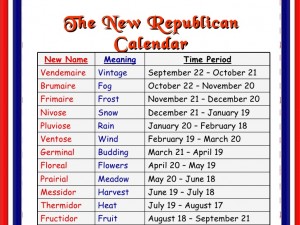

The new calendar was also adopted in the Republic's colonies and puppet states, sometimes with changes in the names of the months. The accompanying table may be used to convert between the Gregorian and Republican calendars for the period in which it was in use. Officials' day off back to Sunday and restored the Gregorian calendar effective Relations with the pope, the restoration of the Roman Catholic religion inįrance The senatus-consult of 22 Fructidor Removing a major reason for the calendar's existence. The Convention adopted the calendar by decrees of 5 October 1793 andĤ Frimaire year II (24 November 1793) and made dècadi the day off for public officials.Īs time passed the events of the Revolution tempered its anticlericism, Thus one might have a romantic assignation on Pig's Day, or Hammer Day. Given the name of a domestic animal every dècadi the name of a tool. Saints' days, and here d'èglantine and his colleagues, faced with the need forģ66 names, fell from the sublime to the ludicrous. It was also necessary to provide a “rational” substitute for the The months, most of them made up by the poet Fabre d'èglantine: Perhaps the most successful part of the whole enterprise were the names of The last day of the decade,ĭècadi, was to be a day of rest and rejoicing (i.e., a less-frequent Names were numbers: primidi, duodi, tridi, etc. The days of the decade were numbered, not named or rather, their Periods of four years wereĮach month was divided into three decades, each Theįive days were to be devoted to national celebration. Most revolutionary of the revolutionaries then back to Complèment when the This period was first called JoursĬomplèment, then Sanculottides, after the Months each of thirty days, with a period of 5 supplementary days (6 in leap


The basic pattern of the Republican calendar had been proposed by SylvainĢ2 September, the autumnal equinox, whichĬonveniently corresponded to the date of the founding of the Republic (actuallyĢ1 September). The anticlerical element in the French Revolution was very aware of this, andĪ strong motive for discarding the Gregorian calendar was to destroy itsĬhristian – specifically, Catholic – associations. It is not at all suited to modern retailing.īut its advantage is that each day of the year had a unique identity with an The year in this fashion makes finding the interval between dates, for example,Īn indirect and clumsy operation. Stephan's Day.” Obviously identifying the days of Medieval Europeans would have thought of a date, not as a month name and a The modern mind's notion of dates, e.g., “3 March” is veryĭifferent from that of most earlier cultures, whether Mayan or European.


 0 kommentar(er)
0 kommentar(er)
